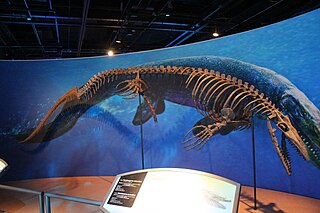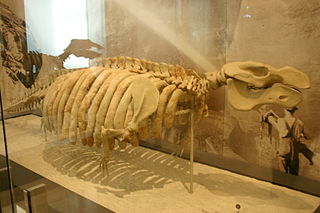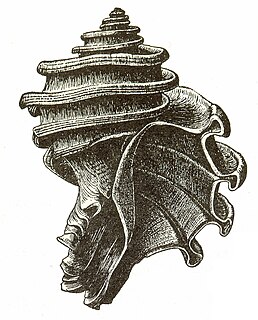
Balaenoptera, from Latin: balaena ('whale') and Ancient Greek: pteron ('fin'), is a genus of Balaenopteridae, the rorquals, and contains eight extant species. The species Balaenoptera omurai was published in 2003. Balaenoptera is a diverse genus and comprises all but one of the extant species in its family—the other species is the humpback whale.

Scanisaurus is a dubious genus of plesiosaur that lived in what is now Sweden and Russia during the Campanian stage of the Late Cretaceous period. The name Scanisaurus means "Skåne lizard", Skåne being the southernmost province of Sweden, where a majority of the fossils referred to the genus have been recovered. The genus contains one species, S. nazarowi, described in 1911 by Nikolay Bogolyubov as a species of Cimoliasaurus based on a single vertebral centrum discovered near Orenburg, Russia.
Benthamaspis is an extinct genus from a well-known class of fossil marine arthropods, the trilobites. It lived during the early part of the Arenig stage of the Ordovician Period, a faunal stage which lasted from approximately 478 to 471 million years ago.
Lachnostoma is an extinct genus from a well-known class of fossil marine arthropods, the trilobites. It lived during the early part of the Arenig stage of the Ordovician Period, a faunal stage which lasted from approximately 478 to 471 million years ago.
Tasmanocephalus is an extinct genus from a well-known class of fossil marine arthropods, the trilobites. It lived during the early part of the Arenig stage of the Ordovician Period, a faunal stage which lasted from approximately 478 to 471 million years ago. Fossils of the genus have been reported from the Karmberg and Caroline Creek Formations of Tasmania, Australia.

Adelophthalmus is a genus of eurypterid, an extinct group of aquatic arthropods. Fossils of Adelophthalmus have been discovered in deposits ranging in age from the Early Devonian to the Early Permian, which makes it the longest lived of all known eurypterid genera, with a total temporal range of over 120 million years. Adelopthtalmus was the final genus of the Eurypterina suborder of eurypterids and consisted the only known genus of swimming eurypterids from the Middle Devonian until its extinction during the Permian, after which the few surviving eurypterids were all walking forms of the suborder Stylonurina.

Megalaspides is an extinct genus from a well-known class of fossil marine arthropods, the trilobites. It lived during the later part of the Arenig stage of the Ordovician Period, approximately 478 to 471 million years ago.
Kingstonia is an extinct genus from a well-known class of fossil marine arthropods, the trilobites. It lived from 501 to 490 million years ago during the Dresbachian faunal stage of the late Cambrian Period.
Parablackwelderia is an extinct genus from a well-known class of fossil marine arthropods, the trilobites. It lived from 501 to 490 million years ago during the Dresbachian faunal stage of the late Cambrian Period.

Taniwhasaurus is an extinct genus of mosasaur which inhabited New Zealand, Japan and Antarctica. The genus was a close relative of the genus Tylosaurus.

Callawayasaurus is a genus of plesiosaur from the family Elasmosauridae. When the first Callawayasaurus fossil was first discovered by Samuel Paul Welles in 1962, it was described as Alzadasaurus colombiensis before being moved into its current genus by Kenneth Carpenter in 1999.

Metaxytherium is an extinct genus of dugong that lived from the Miocene until the end of the Pliocene. Fossil remains have been found in Africa, Asia, Europe, North America, and South America.

Garnbergia is an extinct genus of prehistoric bony fish that lived during the Anisian stage of the Middle Triassic epoch.
Palaeophichthys is an extinct genus of prehistoric bony fish that lived during the Desmoinsian stage of the Pennsylvanian epoch.

Crustaceans may pass through a number of larval and immature stages between hatching from their eggs and reaching their adult form. Each of the stages is separated by a moult, in which the hard exoskeleton is shed to allow the animal to grow. The larvae of crustaceans often bear little resemblance to the adult, and there are still cases where it is not known what larvae will grow into what adults. This is especially true of crustaceans which live as benthic adults, more-so than where the larvae are planktonic, and thereby easily caught.

Ecphora is the common name for a group of extinct predatory marine gastropod mollusks within the family Muricidae, the rocks snails or murexes. The common name is based on the first officially described genus, Ecphora. The entire lineage of these ocenebrinid murexes are descended from the Eocene murex, Tritonopsis. Ecphoras are indigenous to the North American Eastern Seaboard, being found in marine strata from the Late Eocene until their extinction during the Pliocene. Many ecphora species are important index fossils.
Palatodonta is an extinct genus of basal placodontiform marine reptile known from the early Middle Triassic of the Netherlands. It is closely related to a group of marine reptiles called placodonts, characterized by their crushing teeth and shell-like body armor. Palatodonta is transitional between placodonts and earlier reptiles; like placodonts, it has teeth on its palate, but while these teeth are thick and blunt in placodonts, Palatodonta has palatal teeth that are thin and pointed. Palatodonta was first named by James M. Neenan, Nicole Klein and Torsten M. Scheyer in 2013 and the type species is Palatodonta bleekeri. The generic name refers to the row of teeth on the palatine bone of the palate. The specific name honours Remco Bleeker, an amateur paleontologist, who discovered the fossil in the summer of 2010 at the Silbeco quarry near Winterswijk. Palatodonta is known from the holotype TW480000470, a well preserved skull of a juvenile individual.

Atopodentatus is an extinct genus of marine reptile, possibly basal sauropterygian, known from the early Middle Triassic of Luoping County, Yunnan Province, southwestern China. It contains a single species, Atopodentatus unicus. It is thought to have lived between 247 and 240 million years ago, during the Middle Triassic period, about six million years after the Permian extinction. Atopodentatus was an herbivorous marine reptile, although marine reptiles are usually omnivores or carnivores.
Protulophila is a genus of symbiotic or commensal colonial Hydrozoa, known from very small hydroids. These marine hydroids live in the shelly tubes of serpulid tube worms, which are annelids.

Leyvachelys is an extinct genus of turtles in the family Sandownidae from the Early Cretaceous of the present-day Altiplano Cundiboyacense, Eastern Ranges, Colombian Andes. The genus is known only from its type species, Leyvachelys cipadi, described in 2015 by Colombian paleontologist Edwin Cadena. Fossils of Leyvachelys have been found in the fossiliferous Paja Formation, close to Villa de Leyva, Boyacá, after which the genus is named. The holotype specimen is the oldest and most complete sandownid turtle found to date.











